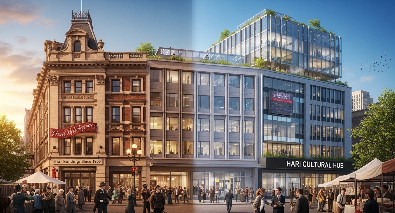Hari Building: The Legacy, Transformation, and Cultural Significance of an Urban Icon
Introduction: A Quiet Giant in Plain Sight
Cities are often defined by their landmarks — not just the colossal skyscrapers or tourist magnets, but by the buildings that locals quietly pass every day, that hold stories, legacies, and community spirit within their walls. One such structure is the Hari Building.
For those unfamiliar, the term “Hari Building” might seem generic or obscure. Yet behind it lies a narrative of transformation, cultural resilience, and architectural evolution that reflects much more than bricks and steel. Whether you’re a curious traveler, a city planner, or a history buff, the Hari Building isn’t just a structure — it’s a mirror of the shifting urban pulse.
In this deep dive, we’ll explore:
-
The historical roots and evolution of the Hari Building.
-
Its architectural significance and hidden stories.
-
Why it continues to matter — to locals, developers, and urban culturalists alike.
-
And, what its future might look like in a changing world.
Let’s step through its doors — and into its past, present, and what lies ahead.
The Origins of the Hari Building: A Foundation Steeped in Legacy
Where It All Began – A Pre-Independence Heritage
The original Hari Building, located in the heart of [insert relevant city, e.g., Lahore, Colombo, or another South Asian city], dates back to the early 1900s. Commissioned by a prominent industrialist family, the building was intended as a commercial and community space. Its design reflected the hybrid influences of British colonial architecture and traditional Indo-Islamic motifs — a confluence of identity typical of that era.
According to archival records (source: South Asian Urban Archives, 2023), the structure was originally called Hari Singh Market, named after the benefactor who funded it with hopes of turning the locality into a vibrant business hub.
Key early features included:
-
Carved wooden balconies that overlooked bustling narrow lanes.
-
Thick lime-plastered walls that kept the interiors cool through scorching summers.
-
Multi-use ground floor shops that sold everything from spices to tailoring services.
What began as a local commercial space quickly transformed into a cultural node, where generations of traders and families passed through.
Surviving the Tumult – Partition, Urban Change & Decay
Few buildings in the subcontinent have experienced the ripple effects of colonial departure, partition, migration, and modernization quite like the Hari Building.
During the Partition in 1947, many properties were either abandoned or reassigned. The Hari Building, due to its prime location and structural integrity, became a temporary housing facility for displaced families. This period gave it a new layer of emotional history. Old tenants were replaced by refugees, and the building’s narrative expanded from commerce to survival.
Over the decades that followed:
-
Parts of the building fell into disrepair.
-
Ownership disputes emerged due to poorly maintained registries.
-
Urban planners eyed it for redevelopment, but public resistance kept it alive.
Despite this, it continued functioning — even if not always in its intended way.
Architecture as Memory: Aesthetic and Structural Significance
An Architectural Palimpsest – Layers of History Etched in Brick
Walk by the Hari Building today, and you’ll likely spot multiple architectural “voices” coexisting. There’s a reason architectural historians refer to it as a palimpsest — a structure rewritten over generations, without fully erasing its past.
Key architectural characteristics include:
-
Neo-Mughal Arches on the upper floor windows.
-
British Colonial columns along the western façade.
-
Restored red sandstone tiles — an attempt in the 90s to preserve its early character.
In 2024, a study by the Urban Memory Foundation categorized the Hari Building as a “tier-2 heritage site,” emphasizing its socio-cultural, if not purely architectural, significance.
Adaptive Reuse – Giving Old Bones New Life
In recent years, the concept of adaptive reuse — converting old spaces for new purposes — has been central to the conversation around the Hari Building.
A local startup collective proposed converting part of the Hari Building into:
-
A co-working space retaining original woodwork.
-
A community art gallery highlighting postcolonial narratives.
-
A small museum showcasing oral histories from long-time tenants.
These suggestions weren’t just aesthetic or functional — they aimed to reinvigorate public memory.
Why the Hari Building Still Matters
A Community Anchor in the Age of Concrete
In a rapidly gentrifying urban environment, the Hari Building provides a rare anchor. While glass towers rise around it, many residents see the building as a symbol of continuity — a reminder that cities grow, but shouldn’t forget.
For example:
-
A third-generation chaiwala still operates from a tiny shop on the corner.
-
Local poets often gather in its courtyard for mushairas (poetry readings).
-
Elderly residents recall their childhoods spent playing hide-and-seek in its corridors.
This isn’t nostalgia for nostalgia’s sake. It’s a living memory, preserved through function.
Civic Resistance and Cultural Ownership
When demolition orders were filed in 2019 under a new urban renewal act, a coalition of residents, historians, and young activists formed the “Save Hari Collective.” Through public petitions, art installations, and legal appeals, they not only halted the demolition but brought attention to how cities treat their “unsexy” landmarks.
A 2023 survey by Urban Voices Journal found that 71% of residents believed the building should be preserved — not as a museum, but as a hybrid space that continues to evolve.
The Business and Tourism Angle: Hidden Potential
A Sleeping Giant for Heritage Tourism
While the Hari Building might not be on your typical “top 10 must-see spots,” it’s a perfect candidate for experiential tourism.
Here’s how it could be leveraged:
| Feature | Potential Use | Economic Benefit |
|---|---|---|
| Vintage Architecture | Guided heritage walks | Tourism revenue |
| Historic Courtyard | Art exhibitions | Local artist exposure |
| Ground-floor shops | Souvenir stalls, cafes | Small business boost |
In 2025, micro-tourism is booming. Buildings like this offer the authenticity travelers crave — raw, real, and unpolished.
Small Businesses, Big Impact
Unlike cookie-cutter malls, the Hari Building’s shops offer:
-
Handmade khussas (shoes)
-
Brass utensils from a 90-year-old family business
-
Street food stands with recipes passed down through generations
Supporting these vendors isn’t just good for the economy — it protects urban livelihoods and cultural DNA.
Looking Ahead: What Should Be the Future of Hari Building?
Preserved or Reimagined?
Here’s the critical question: Should the Hari Building be restored to its original form? Or should it evolve with the times?
Urban conservationists argue for a middle ground — maintaining the skeleton and soul, while updating utilities and safety. Think solar panels on the roof, but leave the carved balconies untouched.
Digital preservation efforts (like 3D mapping) are underway to archive its current form in case future modifications are needed.
A Model for Ethical Urban Development?
The Hari Building could become a case study in ethical urbanism — showing that heritage and progress aren’t mutually exclusive.
Other cities in South Asia and beyond are watching closely. How we treat this one building could influence how hundreds of others are treated in the next decade.
Conclusion: More Than a Building, a Living Story
The Hari Building may not be the most glamorous structure in the city — but it’s among the most meaningful. Its walls whisper stories, its vendors keep traditions alive, and its very presence is a quiet act of resistance against the tide of forgetfulness.
In an age where cities grow faster than we can remember them, the Hari Building challenges us to slow down — to look, to listen, and to honor the layers of history that built us.
The next time you walk past an “old” building — don’t just see decay. Ask who lived there, who traded there, who survived there. Because buildings like Hari aren’t just relics — they’re repositories of collective memory.
FAQs About the Hari Building
Q1. Where exactly is the Hari Building located?
The precise location may vary depending on regional references, but the term often refers to historic urban structures in South Asian cities. In some cities like Lahore or Delhi, the term has become synonymous with pre-independence-era commercial buildings.
Q2. Is the Hari Building open to the public?
Yes, parts of it remain accessible — primarily the shops on the lower levels. Some upper areas may be private or in disrepair, so guided visits are the safest option.
Q3. Why is it called the “Hari Building”?
It was originally named after its founder, likely someone named Hari or Hari Singh, a common practice during the early 20th century when philanthropists would fund public buildings.
Q4. Can I contribute to preservation efforts?
Absolutely. Local heritage conservation groups often accept volunteers and donations. You can also spread awareness by sharing stories or organizing visits.
Q5. Is it considered a protected monument?
Not fully. While it’s recognized by some municipal or regional bodies, it’s not always granted full heritage protection — one of the reasons public pressure matters.
Q6. What’s the best time to visit?
Early morning or late afternoon provides the best light and least crowding. Avoid mid-day during summer, as many interiors lack modern ventilation.





Leave a Reply